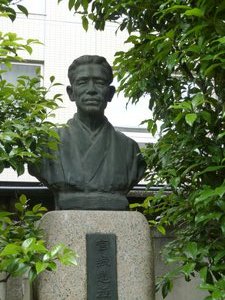Advertisement
Published: June 16th 2019

 Statue of Miyagi Michio
Statue of Miyagi Michio
Miyagi Michio was a distinguished composer and Koto performerThere were several maps containing attractions in the neighbourhood at the hotel. We decided to visit Kagurazaka near Iidabashi station. We took the Sōbu (yellow train) line from Shinjuku. We got off at Iidabashi and used West Exit. We saw a lovely shopping street, Kagurazaka, soon after we left the station.
Miyagi Michio Memorial Hall We planed visiting Miyagi Michio Memorial Hall. This museum was standing in the middle of the residential area. We paid ¥400 for the admission charge and started looking round exhibition rooms. We could hear his masterpiece ‘Haru no Umi (Spring Sea)’ playing in the exhibition rooms. Miyagi Michio is known as the composer and the distinguished ‘Koto’ performer. The exhibition rooms housed the outstanding 80-string Koto – reproduction of the instrument invented by Miyagi, Braille music scores, concert programmes, a Braille typewriter, personal documents and a number of memorabilia. Mark was pretty impressed with the 80-string Koto, which was reproduced by Tsurukawa Music Instrument Company, based on the original, which was burnt by the air-raid.
Miyagi Michio was told at the age of 8 that he had become

 Kengyo no Ma
Kengyo no Ma
This is where Miyagi Michio composedblind and it was an incurable illness, but this made him aim for becoming a composer.
As well as Koto, he was an excellent performer of various music instruments and produced a number of beautiful essays. We also saw Kengyo no Ma, his study – a tea house detached room built in 1948 – where he composed and wrote. I bought a CD of his music at the reception.
We then went to Kagurazaka Dori. This slope street had numerous lovely shops and restaurants – well known Italian and French restaurants, Japanese bakery, Japanese local (Okinawa, Niigata, and Hokkaido cuisine) restaurants – and Japanese stationery shops. We strolled through narrow lanes, e.g. Honta Yokocho, Kakurenbo Yokocho. These narrow lanes were filled with cobbled streets and steps, black coated walls and wooden houses with lattice window bays and it offered an atmosphere of the medieval period. These traditional looking areas have been used for setting for TV series recently and these traditional buildings have been converted into exclusive Japanese restaurants known as Ryotei, where diners are served several courses of luxurious meals and elegant French restaurants. We didn’t chose to go

 Kagurazaka
Kagurazaka
This is not the main street, but we were strolling backstreets as well. to one of these posh restaurants, but had a nice lunch at the stylish looking café on the main street.
There were several historic temples and shrines – Koshoji Temple, Rashomon Tenzenkokuji Temple, and Chikudo Yohato Shrine and Akagi Shrine. We visited these temples and shrines on 27 April.
History of Kagurazaka dates back from Edo period – in 1633 one of the Tokugawa Shogunate members placed streets for Shogunate’s property and then construction of the slope street towards the castle was developed – and this was thought to have formed the slope street of Kagurazaka. I’d heard that there are more than 10 shops which have been running since Edo period (1633–1868), Meiji (1868–1910) or, Taisho (1910–1924). Many of them have been re-built or re-furbished; we weren’t able to identify any shops which have been running since those dates in the day time… we would have spotted if it was quieter or midnight when fewer lights were seen.
We popped in some of the bakery, accessory and the stationery shops. I bought Japanese sweets and hand cream flavoured with Yuzu, citrus fruits.
As we came back to

 Chikudo Yahata Shrine
Chikudo Yahata Shrine
This slope would be covered by cherry blossom's tunnel earlier in April, it was green when we visited there. Iidabashi station area, we looked at the base where one of the gates for Edo Castle stood and walked through the course along cherry blossom trees and overlooked outer moats and restaurants by the water.
It was drizzling in the afternoon on 27 April; we went back to Shinjuku after walking in the park and ate Japanese sweets in our room in the hotel.
Advertisement
Tot: 0.185s; Tpl: 0.01s; cc: 17; qc: 59; dbt: 0.1137s; 1; m:domysql w:travelblog (10.17.0.13); sld: 1;
; mem: 1.2mb

 Statue of Miyagi Michio
Statue of Miyagi Michio
 Kengyo no Ma
Kengyo no Ma
 Kagurazaka
Kagurazaka
 Chikudo Yahata Shrine
Chikudo Yahata Shrine
